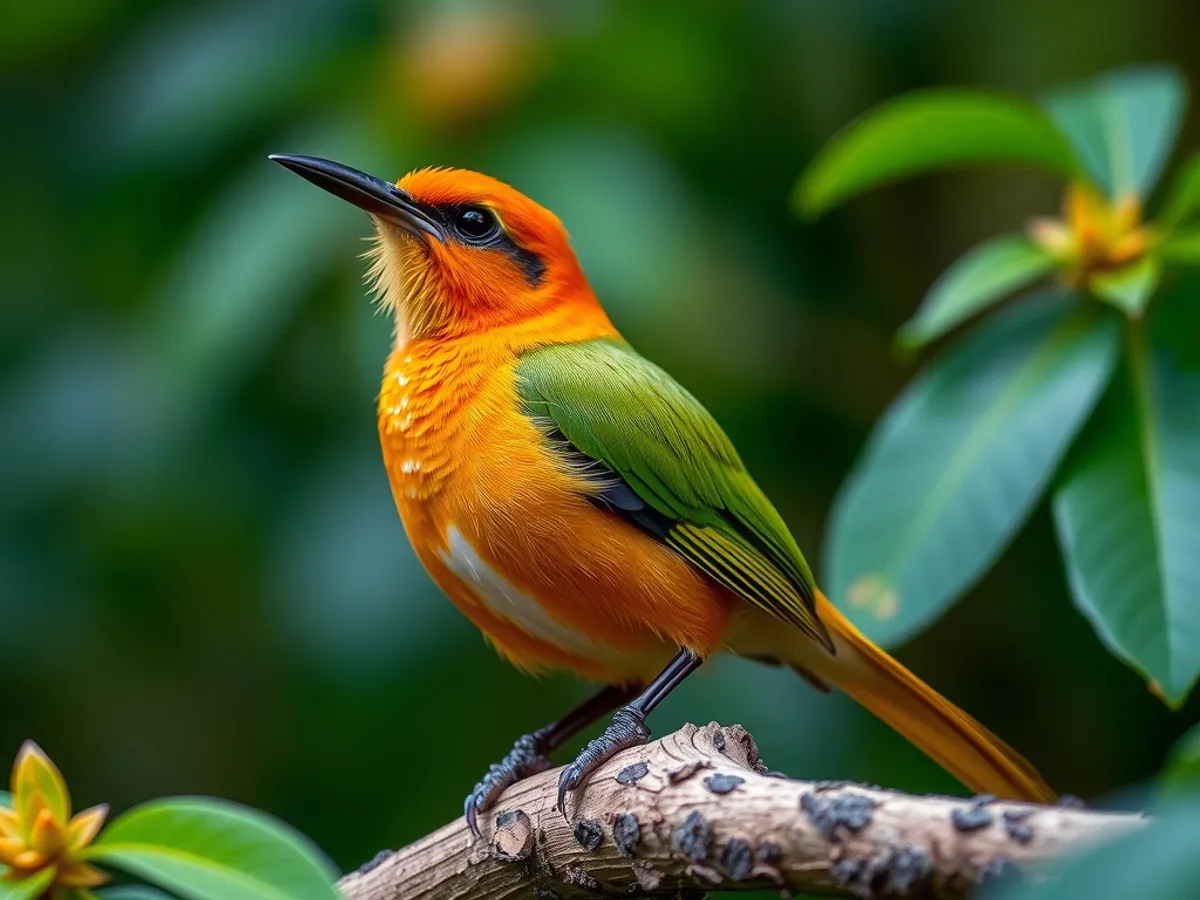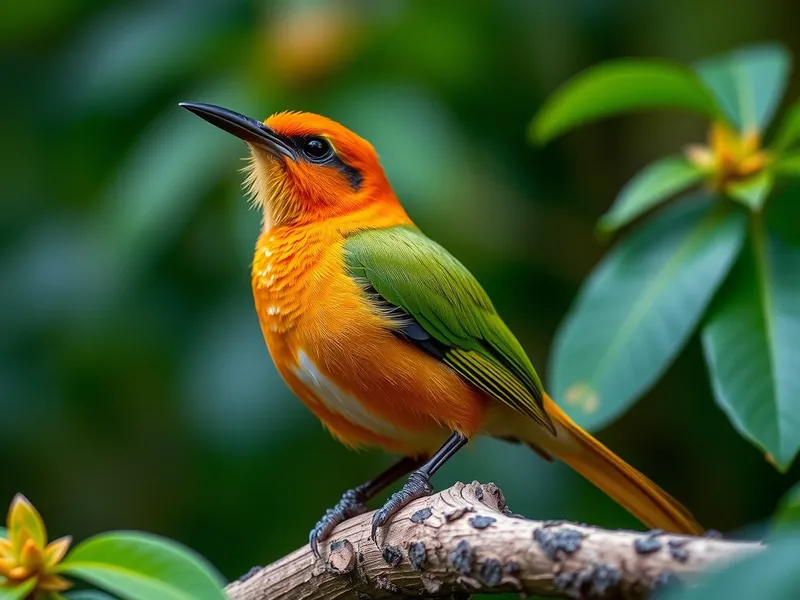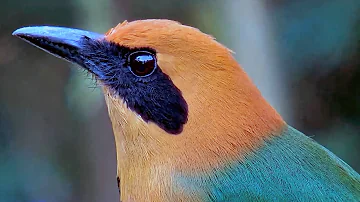
Rufous Motmot
Baryphthengus martii

Meet the Rufous Motmot
The Rufous Motmot is a strikingly colorful bird native to Central and South America, easily recognized by its rich rufous head, neck, and chest contrasted with greenish-blue wings and back. It sports a distinctive racket-shaped tail due to barbless sections near the tip of its elongated central tail feathers. Preferring dense, humid forests, this elusive bird spends much of its time perched quietly in the understory or mid-levels, where it is known for its low, resonant calls. Rufous Motmots play an important role in their ecosystem by dispersing seeds and controlling insect populations.
Classification
Bird
Habitat
Tropical and subtropical moist lowland forests
Diet
Omnivore
Lifespan
8-12 years
Conservation
Least Concern
Weight
130-160 g
📖Fascinating Facts
Unique Tail Shape
The Rufous Motmot's central tail feathers have bare shafts with paddle-shaped tips, creating a distinctive 'racket' appearance.
Forest Specialist
This species prefers undisturbed humid forests, often perching quietly in the mid-story where it is difficult to detect.
Nest Tunnelers
Rufous Motmots dig long burrows in earthen banks for nesting, sometimes sharing these tunnels with other species such as bats.
📋Detailed Description
The Rufous Motmot (Baryphthengus martii) is the largest member of the motmot family, measuring 42–48 cm (16.5–19 in) in length, including its distinctive racket-tipped tail, and weighing 140–170 grams (4.9–6 oz). Its plumage is characterized by a deep rufous coloration on the head, neck, and chest, contrasting with a vivid greenish-blue back, wings, and tail. The face features a black mask bordered by a turquoise-blue line, and the underparts are a warm rufous. The central tail feathers are elongated and end in bare shafts with spatulate tips, a result of natural wear or preening, which is thought to play a role in communication or mating displays. The bill is strong, slightly decurved, and black, adapted for a varied diet. Eyes are large and dark, providing excellent vision in the dim forest understory. Rufous Motmots are secretive and sedentary, often remaining motionless for long periods, which aids in camouflage. Their flight is undulating and direct but typically limited to short distances between perches. They are most active during the early morning and late afternoon, spending much of the day perched quietly in the midstory or lower canopy. Their vocalizations are low, resonant 'hoot' or 'whoop' calls, often repeated and carrying through dense vegetation.
💡 Did you know?
Despite their vibrant plumage, Rufous Motmots are often difficult to spot in the wild due to their secretive nature and tendency to remain motionless in dense foliage.
🔬Research & Sources
Wikipedia Summary
The rufous motmot is a near-passerine bird in the family Momotidae. It is found from northeastern Honduras south to western Ecuador, northern Bolivia, and western Brazil.
Last Modified: 5/24/2025
🎭Behavior & Social Structure
Rufous Motmots are primarily solitary or found in pairs, though small family groups may occur outside the breeding season. They are sit-and-wait predators, perching motionless while scanning for prey, then sallying out to capture insects, small vertebrates, or pluck fruit. Their omnivorous diet includes large insects (beetles, grasshoppers, caterpillars), spiders, small reptiles, amphibians, and a variety of fruits and berries, making them important seed dispersers. Foraging usually occurs in the midstory, but they may descend to the ground to hunt or bathe. They are known to follow army ant swarms to catch fleeing insects. Social interactions are generally limited to courtship or territorial defense, which may involve vocal duets or tail displays. Their daily routine involves long periods of inactivity interspersed with brief foraging bouts.
👶Reproduction & Life Cycle
Rufous Motmots are monogamous, forming long-term pair bonds. Breeding season varies geographically but generally coincides with the onset of the rainy season (March–July in Central America, September–December in parts of South America). Both sexes excavate a horizontal tunnel, up to 1.5–2.5 meters (5–8 ft) long, in an earthen bank, road cut, or streamside bluff, ending in a nesting chamber. The female lays 3–4 white eggs, which are incubated by both parents for about 20 days. After hatching, both parents feed the altricial chicks a diet of insects and small vertebrates. Fledging occurs after 25–30 days, but juveniles may remain near the nest and be fed by parents for several weeks. Nest predation by mammals, snakes, or other birds is a significant cause of nest failure.
🛡️Adaptations & Survival
Key adaptations include the motmot's cryptic coloration and sedentary behavior, which help avoid detection by predators. The racket-shaped tail, unique among motmots, is believed to function in visual signaling during courtship or territorial disputes. Their robust bill allows them to exploit a wide range of food sources, from hard-shelled insects to soft fruits. The ability to excavate long nesting tunnels in earth banks provides protection from many predators and environmental extremes. Their large eyes enhance vision in the low-light conditions of dense forests. Behavioral flexibility, such as following ant swarms or exploiting disturbed habitats, contributes to their ecological success.
📚Research Sources
🎨Cultural Significance
While not as prominent in folklore as some other Neotropical birds, motmots are occasionally featured in indigenous stories and local symbolism, often associated with forest spirits or as omens due to their distinctive calls and elusive nature. In some regions, their striking appearance has made them a subject for ecotourism and birdwatching, contributing to local economies and conservation awareness. There are no widespread traditional uses, but their presence is sometimes considered an indicator of healthy forest ecosystems.
🔬Recent Research & Discoveries
Recent research has focused on the ecological role of Rufous Motmots as seed dispersers and insect predators, highlighting their importance in maintaining forest health. Studies using bioacoustic monitoring have improved understanding of their vocal repertoire and territory size. Genetic analyses have clarified relationships within the Momotidae family, confirming the distinctiveness of Baryphthengus martii. Ongoing research is investigating the function of the racket-shaped tail and its role in sexual selection. Conservation studies are monitoring population trends in response to habitat changes, with some evidence that motmots can persist in selectively logged or secondary forests if sufficient cover remains.
🎥Wildlife Videos

Exotic Rufous Motmot SONGBIRDS That Will Blow Your Mind!
The sound of exotic Rufous Motmot - Songbirds - Exotic Birds. The Rufous Motmot is a large (approx 16.5 In) exotic looking bird ...
Birds & Sounds of Nature

The Baltic | Survival in a Pristine Ecosystem | Animal documentary
Welcome to "The Baltic | Survival in a Pristine Ecosystem", a captivating wildlife documentary that transports you to the serene yet ...
WILD NATURE - Nature animal documentary

Creatures Of The Volcano
A million years ago, Italy was shaped by violent volcanic activity that created mountains and destroyed valleys in a lifeless world.
All Out Wildlife

Rufous Motmot, Baryphthengus martii semirufus, Pipeline Road, Panama, 26 Nov 2021 (3/3)
Just sat there being pretty!
Remco Hofland

Stunning Rufous Motmot Close-up in Panama | January 26, 2024
Rufous Motmots are one of the most colorful visitors to the feeder platform at Panama's Canopy Lodge. This individual sticks ...
Cornell Lab Bird Cams

Rufous Motmot babies
Raided from a nest in Costa Rica these babies were left in a cardboard box to die on the road when the trapper realized they were ...
Toucan Rescue Ranch
🌍Habitat Information
The Rufous Motmot typically inhabits Tropical and subtropical moist lowland forests environments. Rufous Motmots have adapted to their environments with specialized features and behaviors.
Primary Habitat:
Tropical and subtropical moist lowland forests
More detailed habitat information will be available soon.
🛡️Conservation Status
The Rufous Motmot is currently classified as Least Concern. Conservation efforts are crucial for preserving this species for future generations.
Common Threats:
- 🏠Habitat loss and fragmentation
- 🌡️Climate change impacts
- 🎯Hunting and poaching
- 🏭Human-wildlife conflict
⚠️Threats & Conservation Challenges
Although currently listed as Least Concern by the IUCN, the Rufous Motmot faces localized threats from deforestation, habitat fragmentation, and human encroachment, particularly in lowland forests. Their dependence on mature, continuous forest makes them vulnerable to logging and agricultural expansion. Road construction can destroy nesting sites in earthen banks. However, their wide range and adaptability to secondary forests have helped maintain stable populations in many areas. Climate change poses a potential long-term threat by altering forest structure and food availability. Population trends are generally stable, but ongoing habitat loss could cause future declines.
🔬Scientific Classification
Scientific Name
Baryphthengus martii
Classification Hierarchy
🔍 About Taxonomic Classification
Taxonomic classification is a hierarchical system used by scientists to classify and organize living organisms based on shared characteristics and evolutionary relationships.
The system moves from broad categories (Kingdom) to increasingly specific ones, with each animal's scientific name typically consisting of its Genus and species.
📝Community Notes
Share your observations and insights about the Rufous Motmot with our community of wildlife enthusiasts.
Join Our Community
Sign in to share your observations and connect with fellow wildlife enthusiasts.
Sign In to ContributeNo community notes yet
Be the first to share your observations about the Rufous Motmot!
Explore Rufous Motmot
Select a tab above to learn more about this amazing animal.
📸Photo Gallery
No photos available for this animal yet.
🌟Discover More Wildlife
Continue your journey of discovery with more fascinating animals from our database
